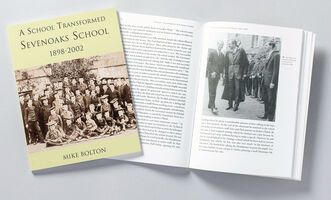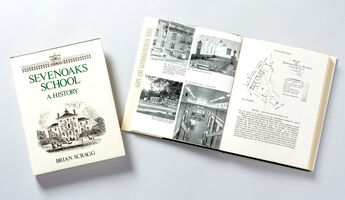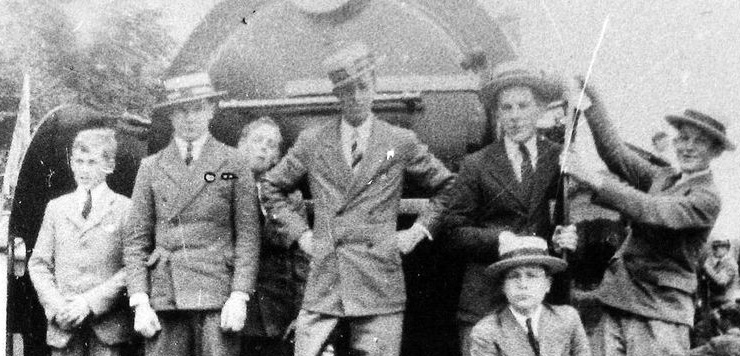The School Archive
Delve into Sevenoaks School's history with the fascinating articles below researched and written by school archivist Sally Robbins.
Several histories of the school by former staff and OS are available to buy:
A School Transformed: Sevenoaks School 1898–2002 by Mike Bolton, former Undermaster
Sevenoaks School: A History by Brian Scragg, former Undermaster
History of Music at Sevenoaks School 1877-2010 by Peter Young, former Head of Music
Sevenoaks written and illustrated by Kevin Sacco (OS 1970)



Email the archivist for queries relating to Sevenoaks School's history, to purchase books or to donate an item to the archive.
Sevenoaks School Locomotive No. 935

There are not many photographs in the school archives from the 1930s, and those that we do have are mainly of house groups or sports teams. There are two, however, which show pupils in a more relaxed environment, climbing onto the footplate of a large locomotive festooned with bunting, in their suits and biffs. The photographs were taken eighty years ago this summer on the occasion of the visit to Sevenoaks (Tubs Hill) Station by the newest Schools’ Class locomotive, No.935 Sevenoaks School.
The Schools’ Class locomotives were a group of forty steam engines designed in 1930 specifically for the Southern Railway to cope with the operating difficulties on the Tonbridge/ Hastings and Chatham/ Ramsgate lines – narrow tunnels and steep gradients; and with enough speed to accommodate the tight boat-train schedules to Dover and Folkestone.
For the technically minded, the engines used elements of both the Lord Nelson and King Arthur classes (hence their nickname of a “Three Quarter Nelson”); were a V Class engine with a 4-4-0 wheel arrangement (ie. 4 driving wheels, and 4 leading wheels, each 6’ 7” in diameter); had a fuel capacity of 5 tons of coal and 4000 gallons of water; and a round topped firebox. Originally painted olive green the engines were subsequently brightened up with a malachite shade.
It was decided to name the new Class after southern Public Schools in recognition of the amount of passenger traffic to and from these institutions at the beginning and end of each term. Prior to starting its service, each engine visited the nearest station to its nomenclature for an inspection and naming ceremony by the pupils. The Sennockian correspondent for that day at Tubs Hill in July 1935 recalled that “the driver and fireman became the most patient and interesting schoolmasters for three hours on end…”
The first engine built was No.900 Eton; Sevenoaks School was one of the last to be built, in 1934 at the Eastleigh Works in Hampshire. Only Uppingham objected to the use of its name and in that same year No.923 ‘s nameplate was hastily removed and replaced by Bradfield. Later engines began also to be named after schools further afield such as Repton (926) and Shrewsbury (921).
The Daily Mail published an entire article on their introduction: “This is really excellent news. No one can reproach the Southern Railway with carelessness…the only drawback to these educated engines, as far as I can see, is there is bound to be a good deal of intercollege rivalry. It is, for example, not difficult to imagine a certain friction arising from Eton’s persistent whistling of its Boating Song..”.
No.935 was unique in being modified in 1938 as part of streamlining trials just before the outbreak of War. They were ultimately unsuccessful and the original design was soon reverted to. Electrification of the Southern line began in 1957 and the Schools’ Class engines began to be withdrawn from service. In service for thirty years - “They are, in fact, the last word in modern locomotive practice and power” [Sennockian 1935].
Sevenoaks School, which had done over a million miles in its lifetime, last ran on 29 December 1962. It was eventually scrapped; only the brass nameplates were salvaged, one of which is in the School Archives. The original 5’ model of the train was donated to the school in 1963 by OS Maurice Finch; the current model in the School Bursar’s office is a later, and smaller, version. An article in the Sennockian of 1964, shortly after No.935 had been sent to the scrapyard, ended on the note that “in a short time…her individuality will vanish, as her features are committed to the flames to be reduced to a lifeless mass and remain in the minds of men a memory of the time that was – requiescat in pace”.
